Queen’s Park, the oldest football club in Scotland who saw great success in the Scottish Cup in the late nineteenth century. The Glasgow club holds an iconic status in football and has been well known for its commitment to amateurism and fair play. The club has produced several notable players over the years, including many Scotland internationals such as Liverpool fan favourite Andy Robertson.
In recent years, Queen’s Park has struggled to maintain its position in Scottish football and was relegated to the fourth tier of the football pyramid at the end of the 2017/18 campaign. However, fed up with losing their best players for free, in 2019 the club made the decision to turn professional and it’s safe to say, they have not looked back since. After winning the Scottish League Two in 2020/21, Queen’s Park then surprised many by immediately gaining promotion from League One via the playoffs the following season.
Current manager Owen Coyle took charge of the club in June 2022 and has continued the upward trajectory. The Spiders are enjoying a wonderful season where they find themselves in the frame for promotion to the Scottish Premiership. They currently sit second in the Championship, one point behind leaders Dundee and on course to qualify for the playoffs as a minimum. Surely, a third consecutive promotion couldn’t be on the cards, could it?
This tactical analysis will focus on the tactics Owen Coyle has implemented during his tenure at Queen’s Park. We will analyse the style of play he has brought to the club and why they have continued to be so successful despite the step up.
Preferred formations
To begin this analysis, let’s take a look at the formations and tactical setup that Coyle has used most often this season.
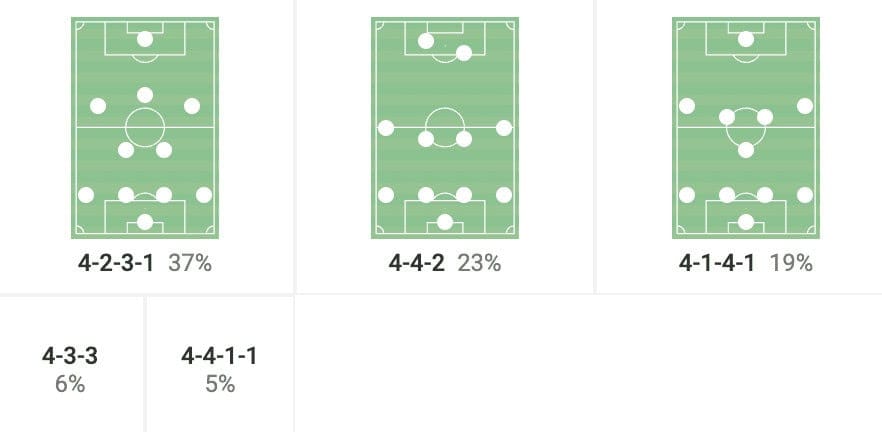
From this graphic, we can see that he mostly favours a 4-2-3-1 formation. We can also see that this is very fluid as Queen’s Park also uses a 4-4-2 and 4-1-4-1 quite often. All of these tactical setups are very similar which suggests that it is a relatively easy transition between them for the team.
For example, a 4-2-3-1 can easily transform into a 4-4-2 if the attacking midfielder pushes forward to create a front two and the wingers just drop back a little to form a midfield block of four. Many managers favour this when pressing as the two forwards can put pressure on the opposition centre backs whilst the midfielders can cut off passing lanes to prevent the opponent from successfully building from the back.
Always progress the ball
When analysing Queen’s Park’s style of play in the attacking phase, what stands out the most is their consistency when progressing the ball. Under Owen Coyle, they average 156.84 forward passes per 90 compared to 116.32 lateral passes per 90 which demonstrates their determination to always ensure the ball moves vertically. In addition to using forward passes to progress the play, the manager is more than happy for his players to use their own initiative and carry the ball into the attacking third.
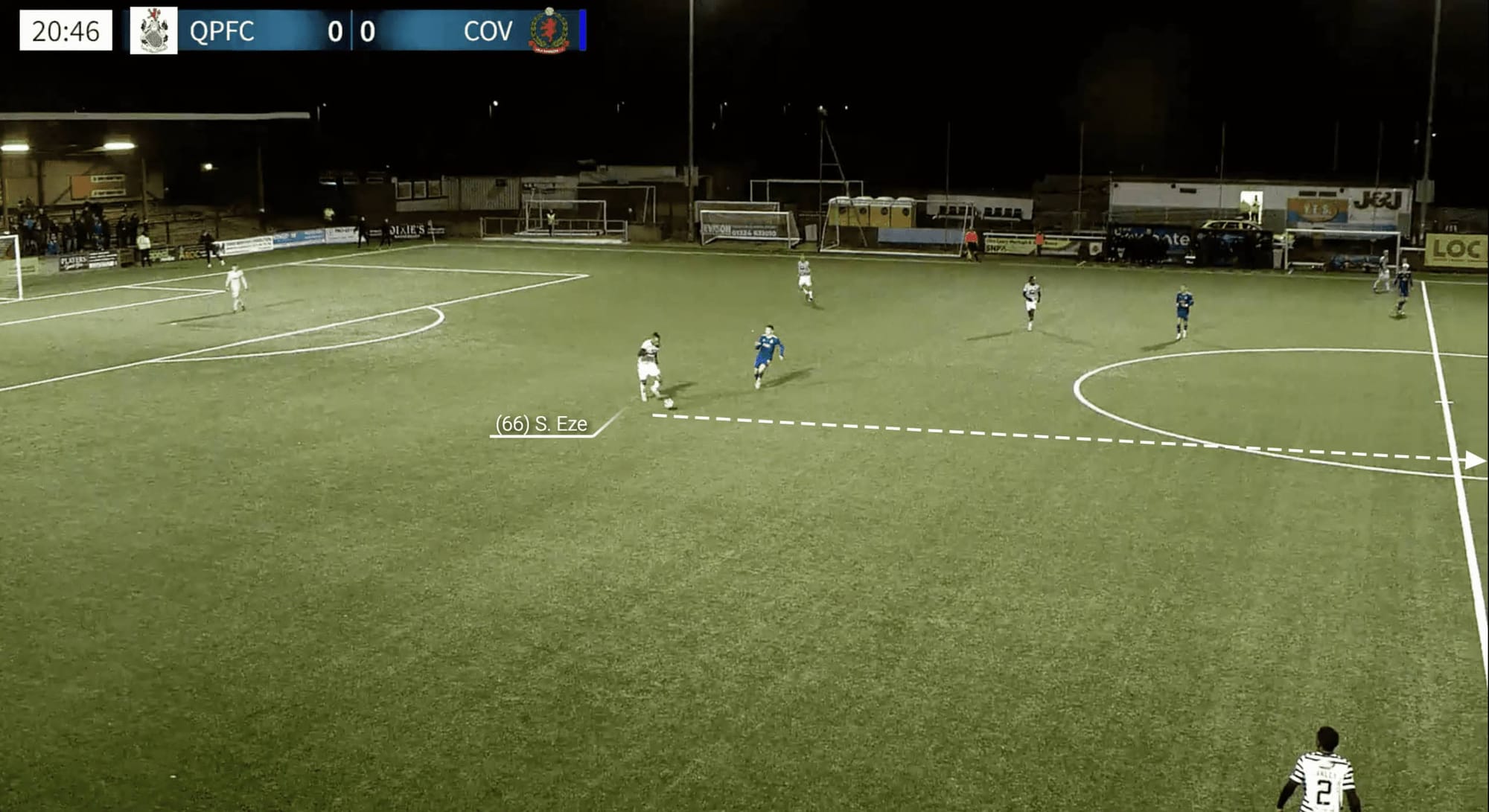
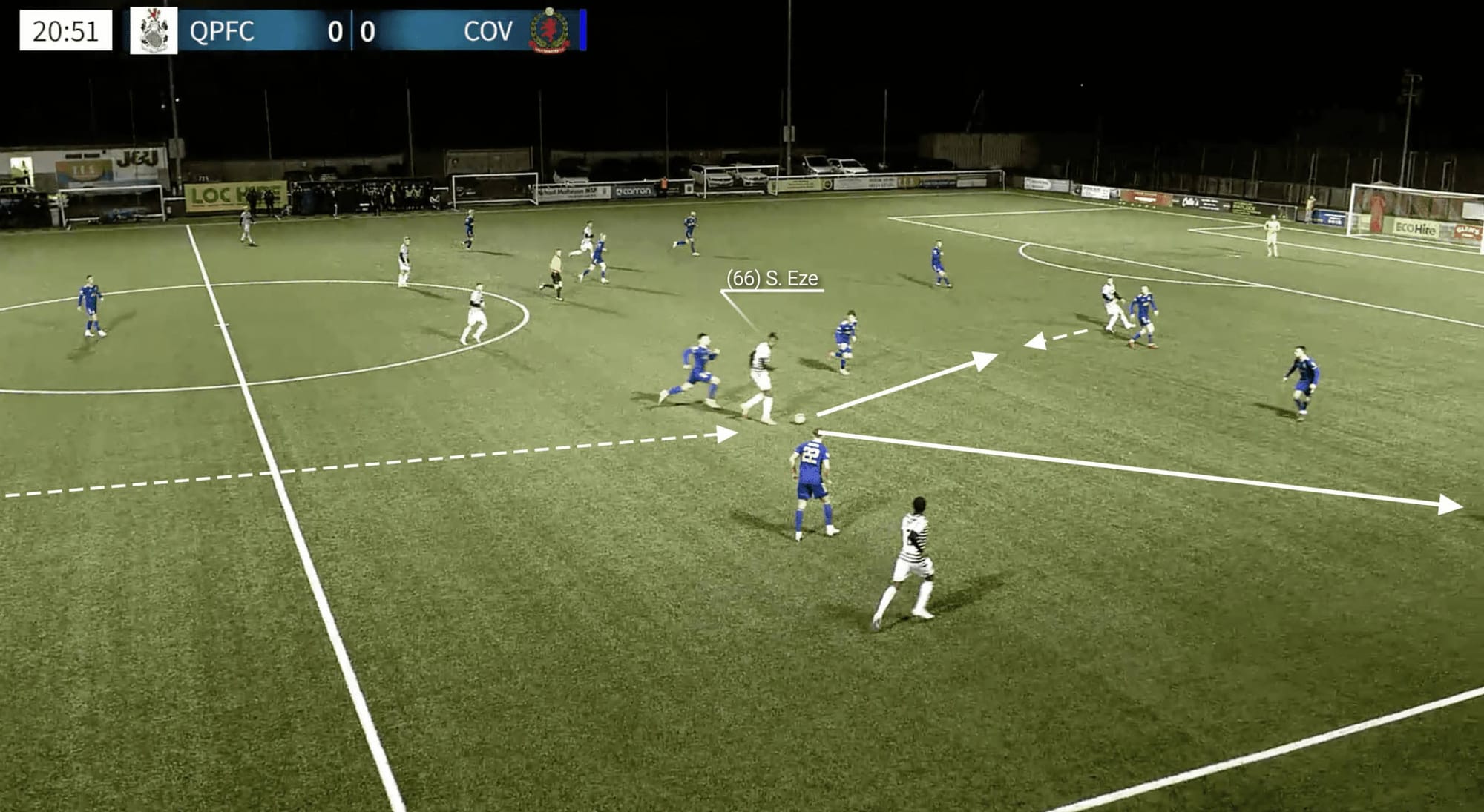
Figures 1.1 and 1.2 represent a good example of Queen’s Park driving the ball forward. Here, we can see centre-back Stephen Eze carrying the ball out of defence. This initiates an attack from the back, bypassing the midfield and creating more direct passing options to teammates further up the field. This means that Queen’s Park can utilise a more dynamic attack, which allows them to catch the opposition off guard.
Additionally, this means that Owen Coyle’s side can break through the opposing lines, disrupting the opposition’s defensive shape and opening up space for their own attacking players. This can also help to stretch the opposition and create more gaps in their defensive structure, as we can see in Figure 1.2, with the opposition players so focused on Eze, it means there are huge gaps for other Queen’s Park players to use to their own advantage. In terms of the data, Eze averages 4.83 passes to the final third per 90, while Lee Kilday averages 5.07 and Charlie Fox averages an impressive 8.67 which demonstrates Coyle’s commitment to playing this way.
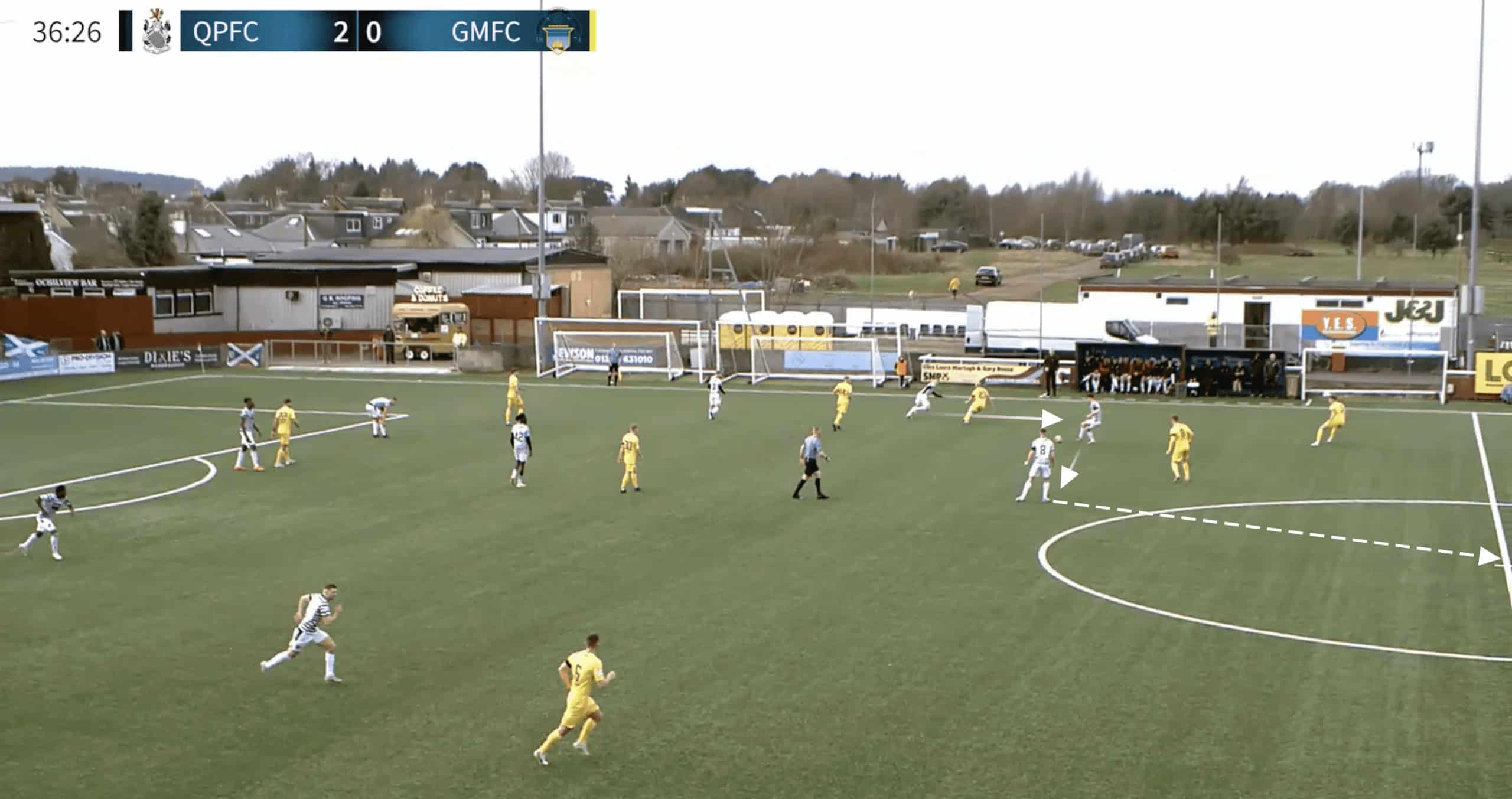
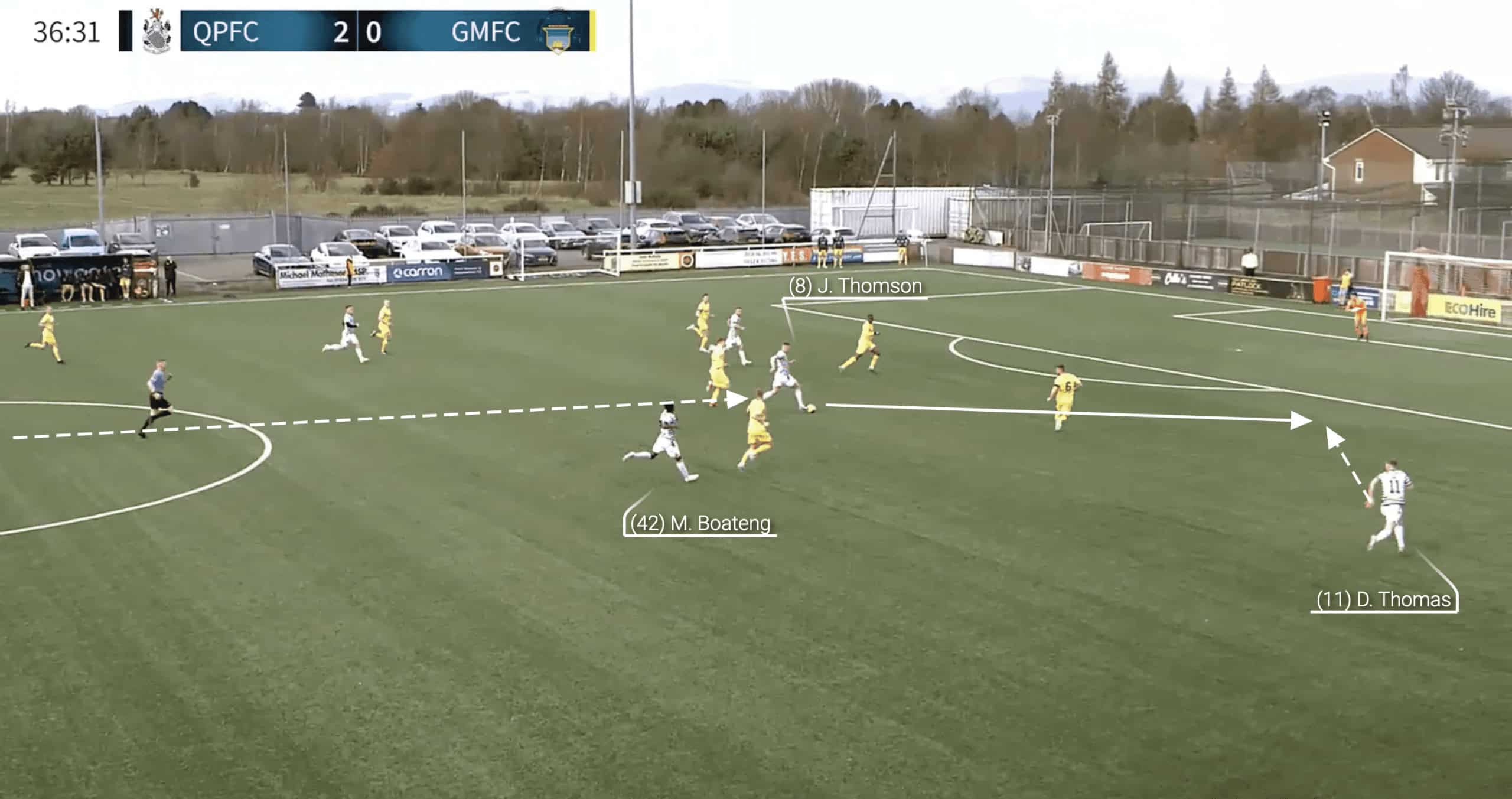
In this instance, we can also see how quickly Queen’s Park can transition from defence to attack thanks to their individual capabilities to carry the ball up the pitch. In Figure 1.3, the Spiders have regained possession and immediately look to launch a counterattack. The ball is played to the feet of midfielder Jack Thomson who proceeds to carry the ball right up the pitch to the Greenock Morton penalty area as we can see in Figure 1.4.
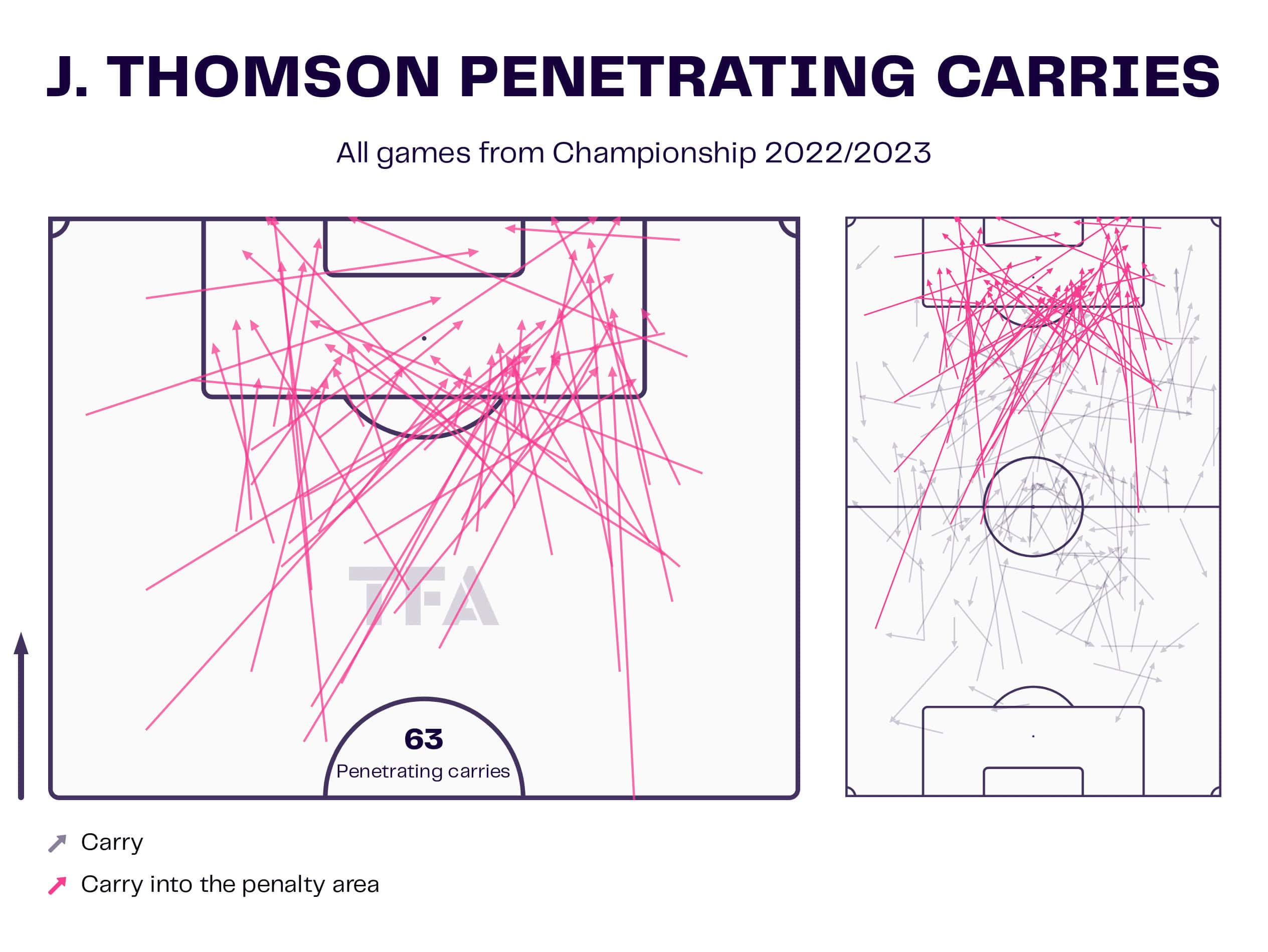
The data visual above shows how effective Thomson has been in the Queen’s Park attack this season. As a team, the Spiders have completed 268 penetrating carries so far this campaign, 63 of them have come via Thomson’s wonderful ability to carry the ball. This is the highest number of penetrating carries by an individual player, demonstrating that the 23-year-old has become an important player under Owen Coyle and is perhaps something of an unsung hero in this Queen’s Park team.
The midfield general
The Queen’s Park players work incredibly well as a team as we have established and will continue to show throughout this tactical analysis. However, there has been one player that has stood out this season – Malachi Boateng. The 20-year-old who is on loan from Premier League side Crystal Palace has been a revelation in midfield for Owen Coyle’s side.
Usually deployed as a central midfielder or occasionally a defensive midfielder, the youngster’s impressive performances have been acknowledged by the manager. After an early season victory over Partick Thistle, Coyle said:
“He bossed the midfield at times”. Clearly delighted with the loanee’s starring role in the win, the manager went on to say: “Fair play to Thistle as they played well, but it didn’t phase the kid. He stood up, got his tackles in, passed and moved the ball when he had to.”
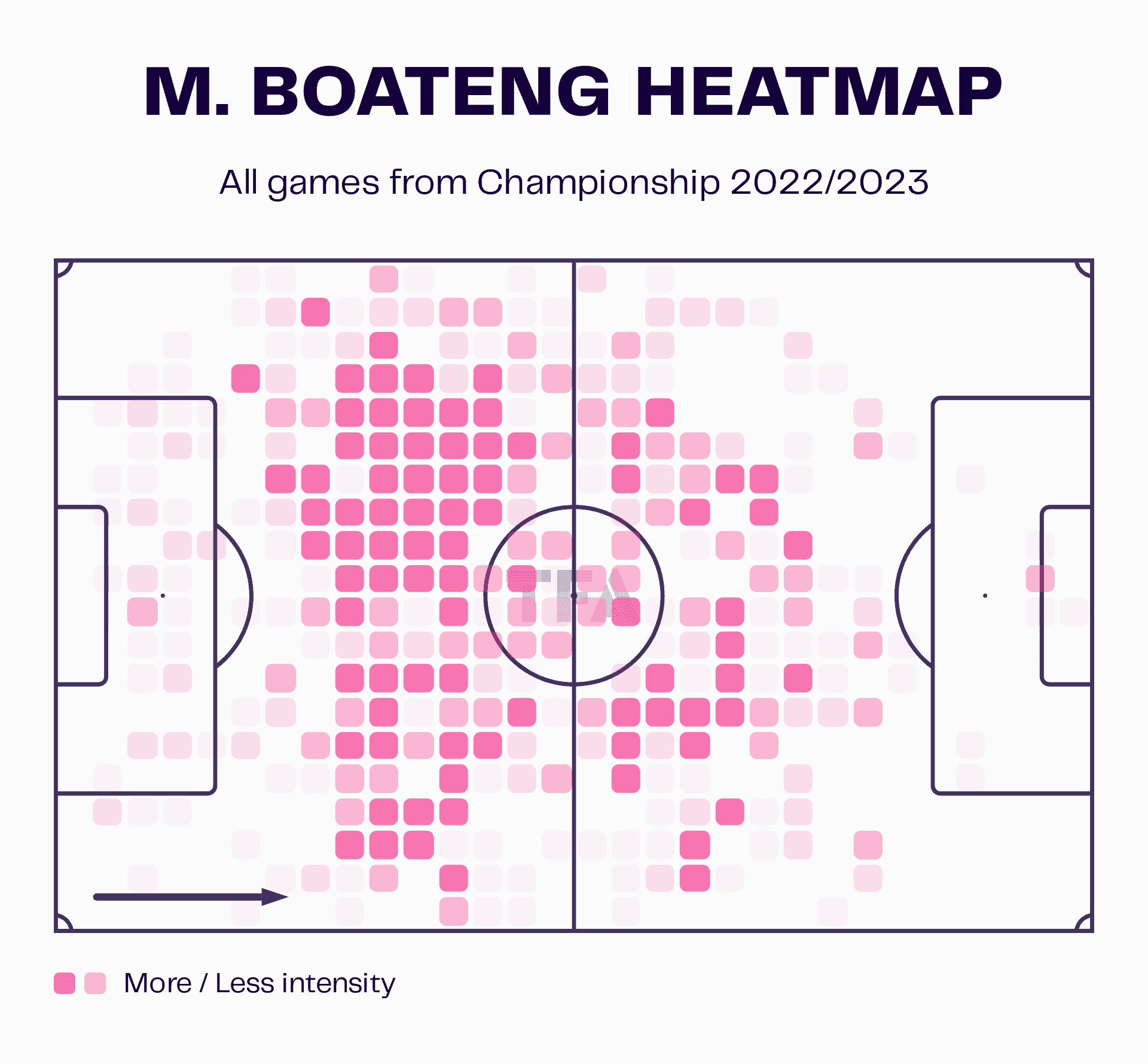
We can see from this heatmap that Boateng does most of his work on the pitch. He primarily works between both penalty areas, shielding the defensive line from opposition attacks and looking to provide a passing outlet when Queen’s Park is on the attack. He is the engine room of the team, responsible for breaking up opposition attacks, distributing the ball to teammates, and providing a link between the defence and attack.
Boateng is physically and mentally strong, able to make quick decisions and possesses excellent ball control and passing skills. He has a strong work rate, often covering a large amount of ground during the course of a game, and proves to be effective in all phases of the game.
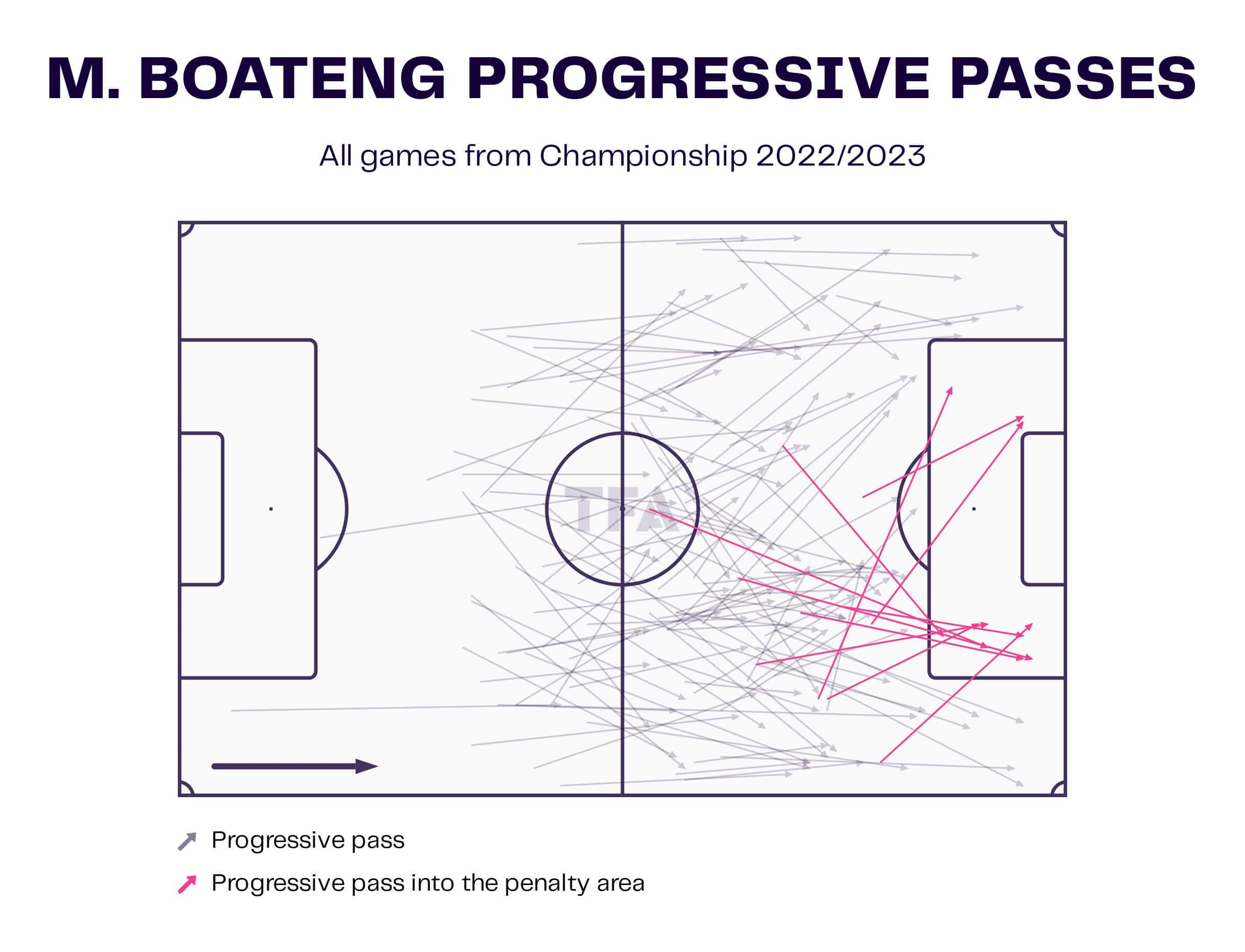
This data visual above shows us Boateng’s progressive passes throughout the course of this season. We can see that he looks to play line-breaking passes with enough pace and accuracy to penetrate through the opposition’s defensive line, opening up space and creating opportunities for attacking players to exploit.
The highly rated midfielder’s love of a line-breaking pass is displayed below in Figures 2.1 and 2.2. We can see the wonderful pass played by Boateng targeted towards the attacking player, in this case, Connor Shields who has made a run towards the flank, dragging several defenders with him, creating a vast amount of space for fellow Queen’s Park attackers to exploit.
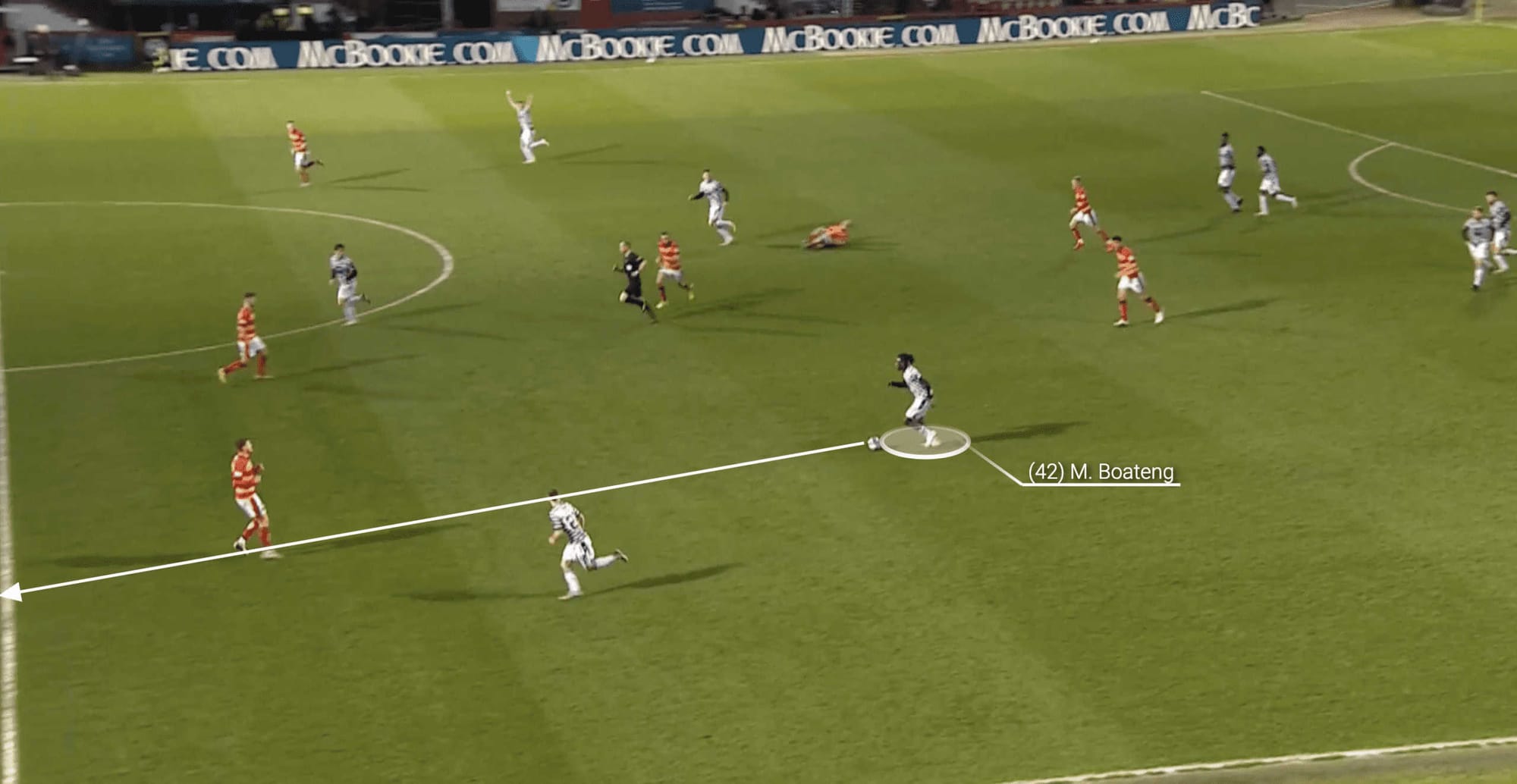
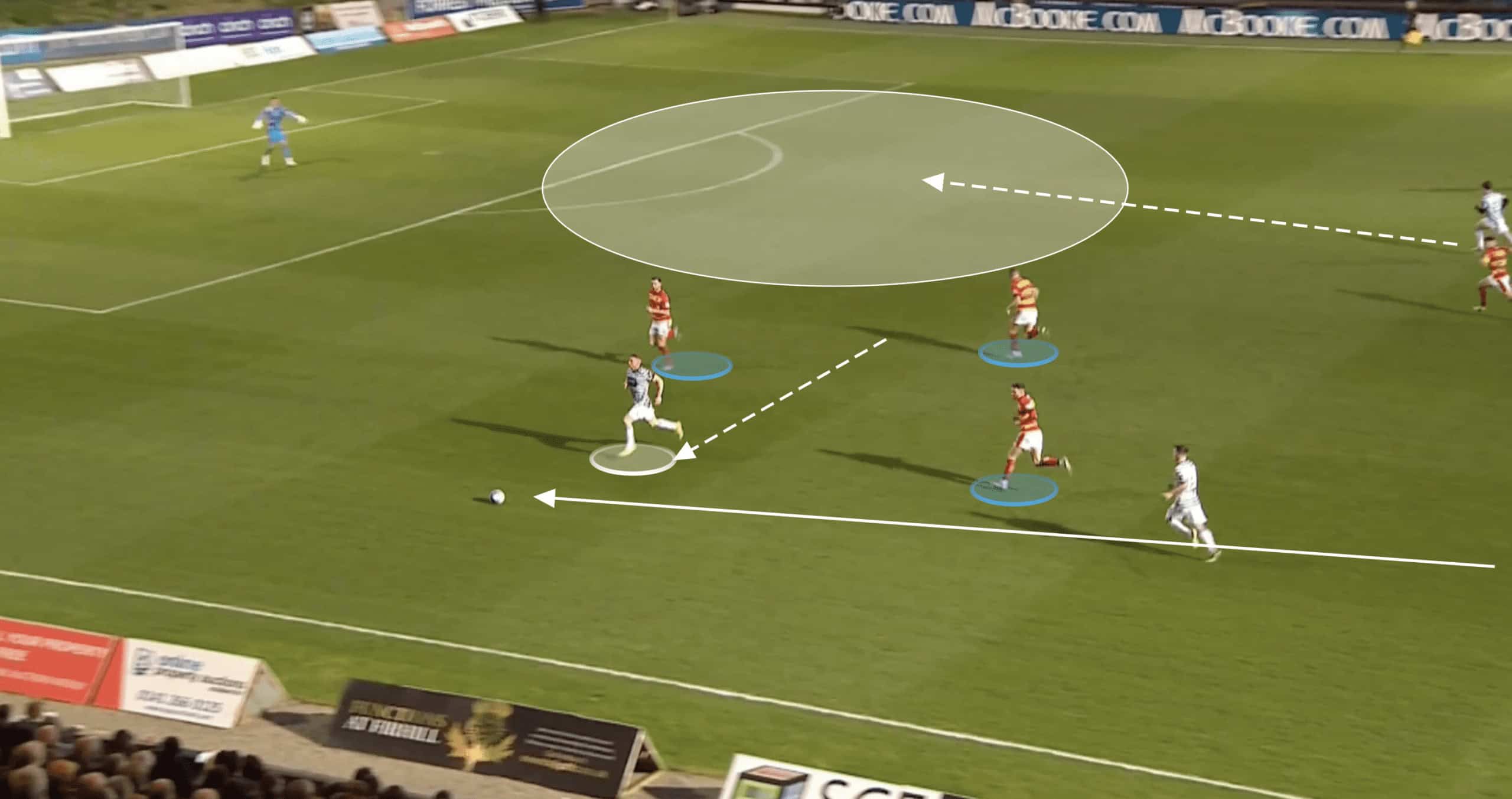
Line-breaking passes are particularly effective in the final third of the field, where there is less space for attacking players to operate. By playing a well-executed line-breaking pass, a team can quickly and efficiently transition from defence to attack and create scoring chances. This is exactly why Malachi Boateng has been such an important player for Owen Coyle this season.
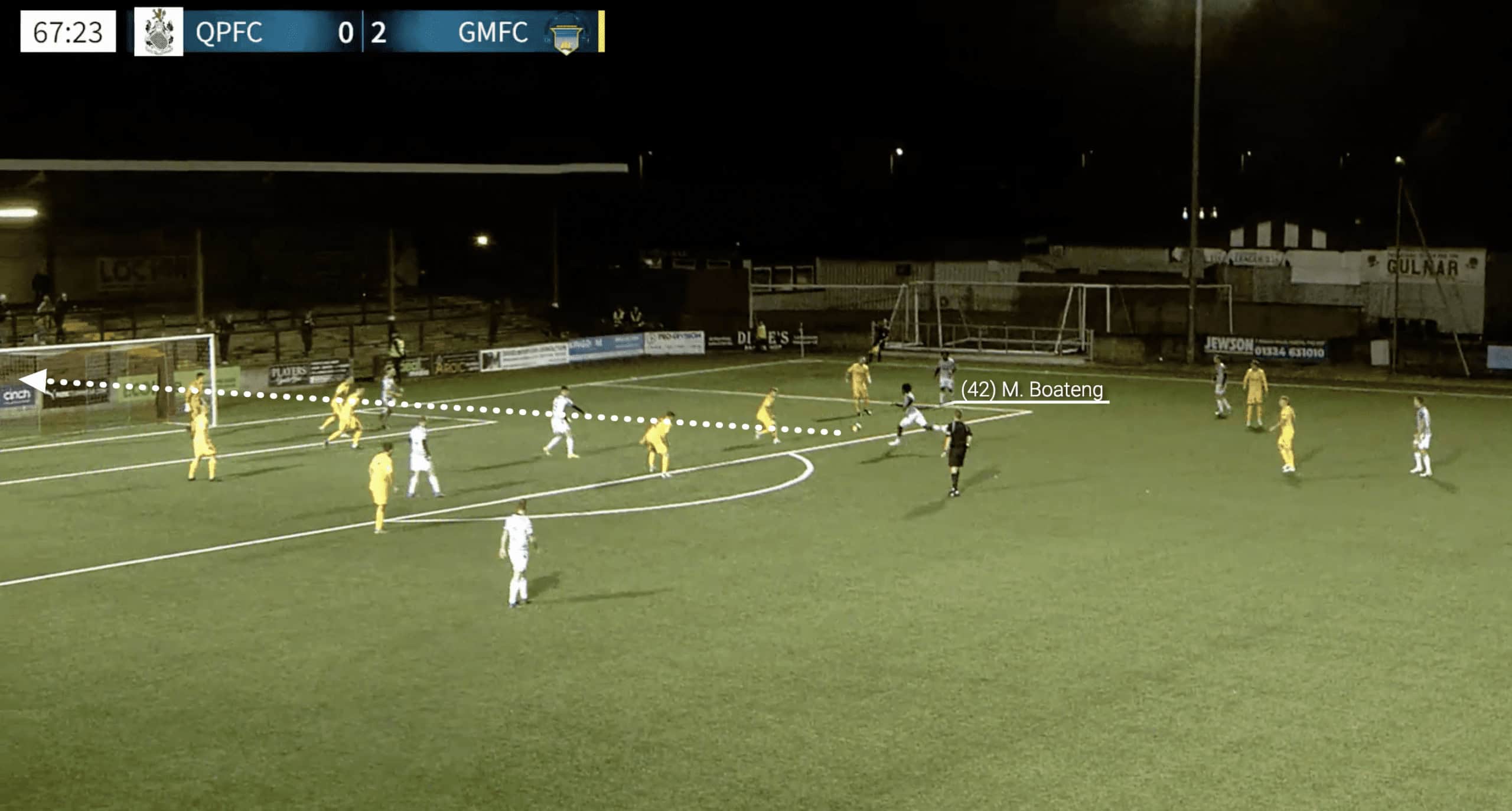
Moreover, when Queen’s Park are in the attacking phase, Boateng’s marshalling of the edge of the penalty area is incredibly useful. He is on hand to recycle possession to ensure that his team do not lose possession and risk being under pressure due to an opposition counterattack. Additionally, as shown here in Figure 2.3, it means that he is available to unleash an effort on goal from just outside the area.
An aggressive press
Moving on, if we analyse how Coyle sets his team up defensively, it is incredibly apparent that the former Bolton manager favour’s an aggressive pressing system. Queen’s Park looks to counter-press at any available opportunity. The primary goal of counter-pressing is to win the ball back as quickly as possible before the opposition has a chance to transition into attack. By doing so, Queen’s Park can immediately look to attack. This is a great way of preventing the opposition from transitioning into attack quickly, therefore limiting their opportunity to counterattack.
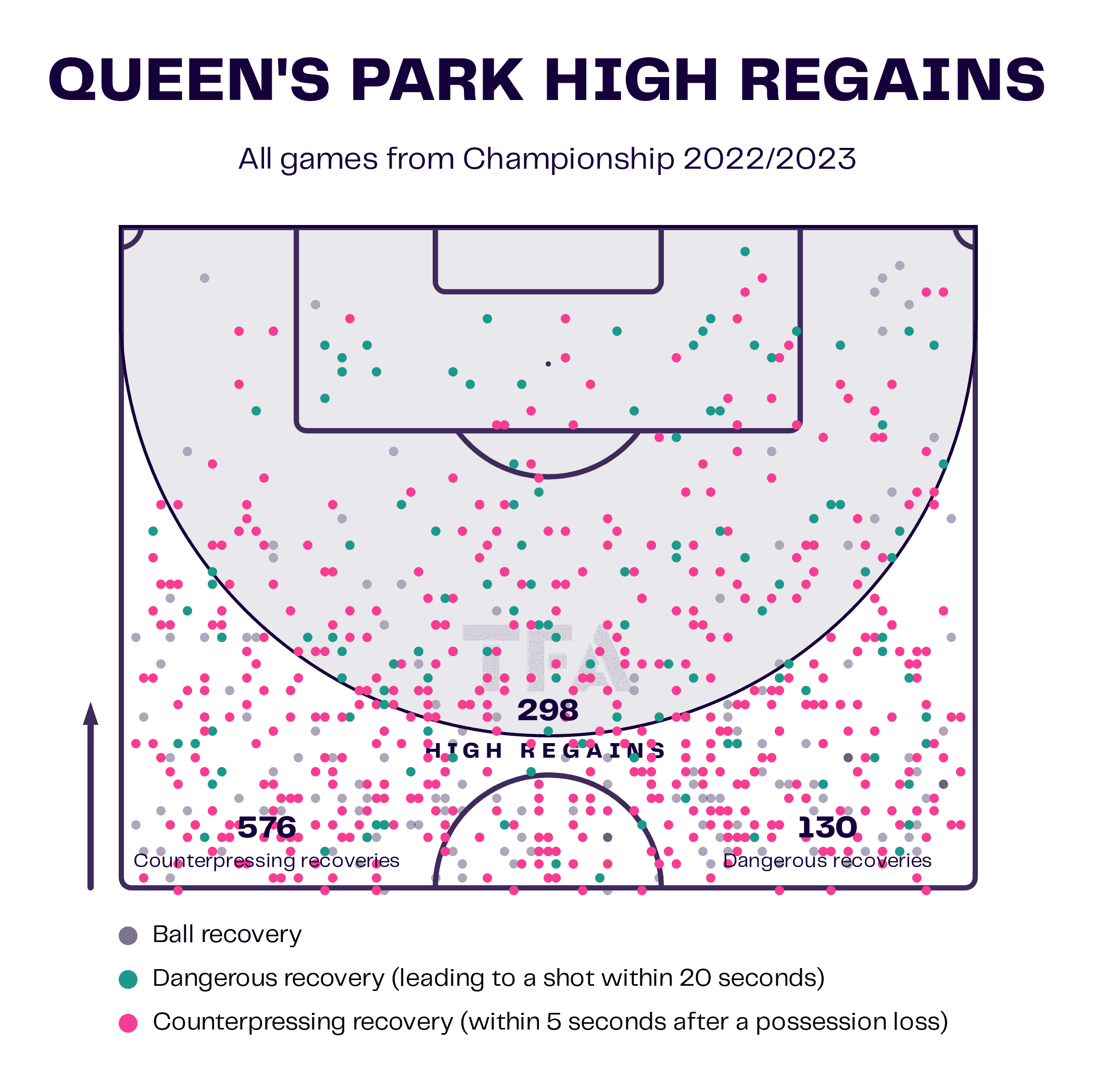
This data visual shows us that Queen’s Park have made 576 counter-pressing recoveries so far this season, indicating they look to win the ball back instantaneously after losing possession. 298 of them have been classed as high regains, meaning that Owen Coyle’s side have regained possession in the attacking third and 130 of those have led to a shot within 20 seconds of recovering the ball. The Spider’s average PPDA (Passes Per Defensive Action) is 8.76 this season which further demonstrates their desire to regain possession rapidly.

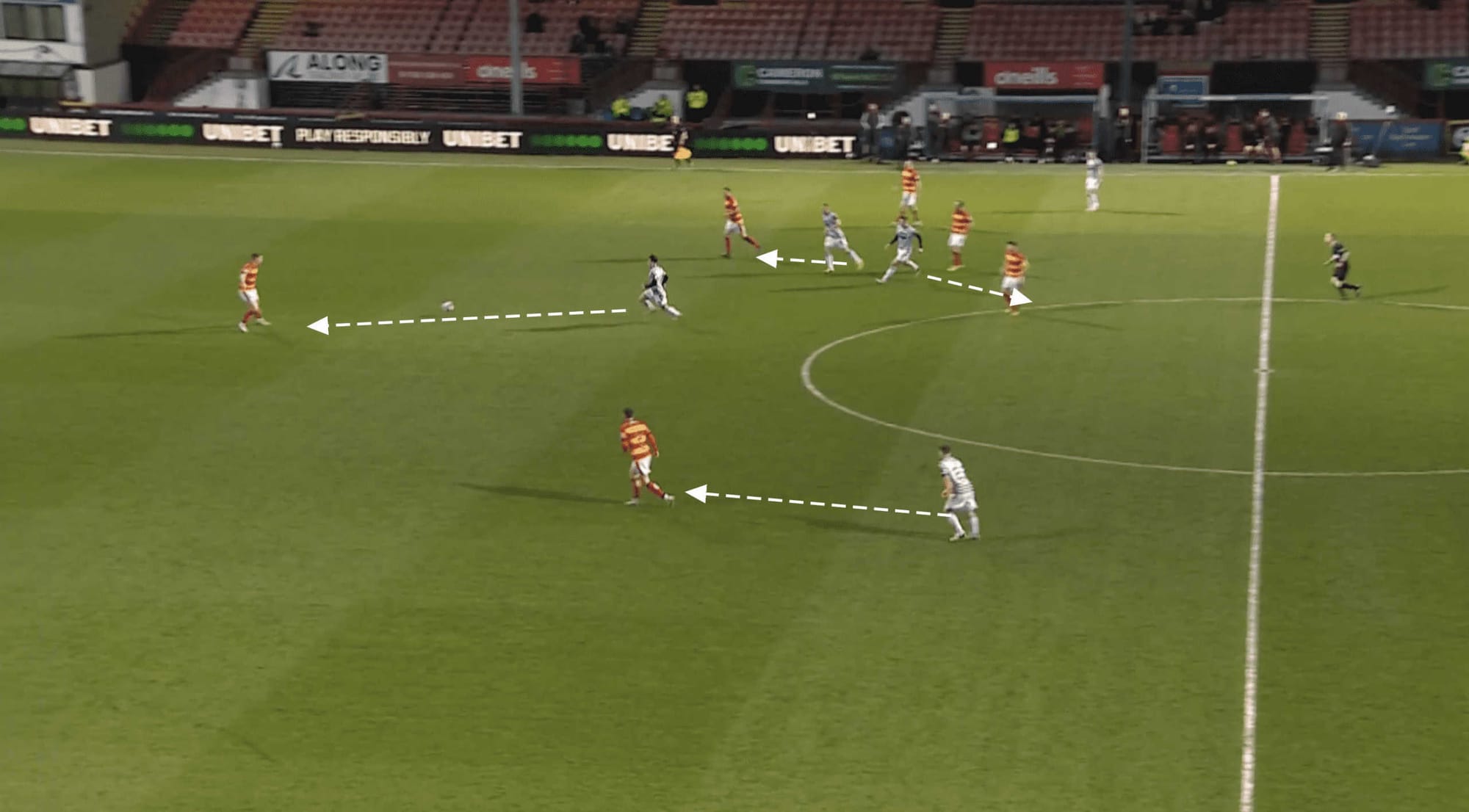
Here, in Figures 3.1 and 3.2 we can see the Queen’s Park press in full effect. Figure 3.1 shows us how there is a Queen’s Park player ready to press any opposition player as they look to recover possession quickly. As a result, we can also see that Coyle’s team have moved much further up the pitch as a cohesive unit which means it becomes increasingly difficult for the opponent to play through or around the press. In Figure 3.2, we can see how Queen’s Park’s press has forced their opponent to play backwards due to there being no available passing lanes.
High pressing forces the opposition into making mistakes, such as bad passes or poor touches, which can lead to turnovers and scoring opportunities. This means that Queen’s Park can transition quickly into attack and catch the opposition off guard. Moreover, by applying high-pressure Owen Coyle’s team can control the tempo of the game and prevent the opposition from developing their attacking rhythm.
Low block issues
However, there are some rather glaring issues within the Queen’s Park defensive setup. On average, they concede 1.3 goals per 90 which is something that has the potential to derail a promotion push should this number increase. An element of their play in the defensive phase which has an impact on this is some rather woeful low-block defending.
The Spider’s poor defending has seen them be on the receiving end of some hefty defeats, including a 5-0 loss at Ayr United, a 3-0 loss away at Dundee and recently a 4-0 loss to Partick Thistle. These losses could have a significant impact on their promotion chances, particularly as they seem to struggle against fellow teams vying for playoff places.
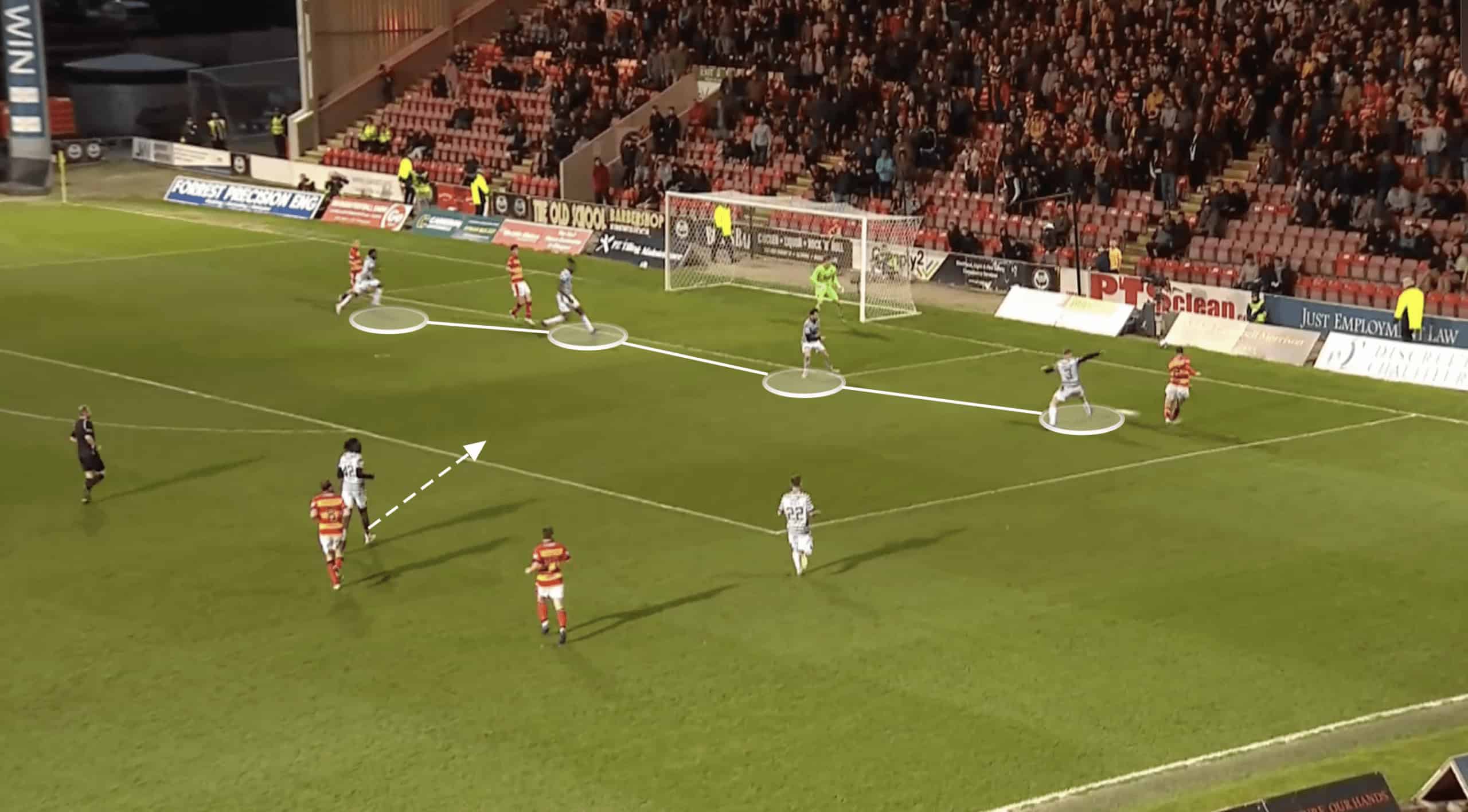
We can see in Figure 3.3 that the Queen’s Park players have dropped back into a low-block defensive line, there are no issues with this in itself. However, there is a noticeable lack of cover from any other players. Additionally, there is a vast amount of space available in and around the edge of the area so, should the opposition winger look to cut the ball back into this area, there is every chance that he will find an on-rushing teammate.
Of course, the primary consequence of poor low-block defending is that it can lead to conceding goals. If a team is not able to defend its own box effectively, this means they are far more likely to concede. This can also increase the pressure on the team’s goalkeeper and defenders, as they may have to deal with a higher volume of shots and crosses.

The data visual above also confirms that Owen Coyle’s side have conceded a much higher number of expected goals – 51.66 compared to that of fellow promotion contenders Dundee who have conceded 32.87. We can also see that goalkeeper Calum Ferrie has prevented 14.66 goals this season indicating it could be far worse without him between the sticks.
If Queen’s Park do gain promotion to the Scottish Premiership, they are going to have to sort out their defensive strategy as there are serious question marks over whether they have the capabilities to cope against the likes of Celtic and Rangers’ prolific attackers.
Conclusion
The last few years have been wonderful for Scotland’s oldest club, back-to-back promotions and on course for a third. Owen Coyle has taken over and for the most part, managed to keep the club on their upward trajectory. He has implemented a very positive mindset in this group of players as they continually look to progress the ball into the attacking third.
Queen’s Park have shown throughout the season that they can counter-press effectively which has been of great use to them as they look to mount a promotion charge.
As we have established, there are some defensive issues that need to be ironed out, especially if they do make the step up to the Premiership. Overall though, the club is in a very positive place at the moment and looks like it is set to continue for a while.





Comments